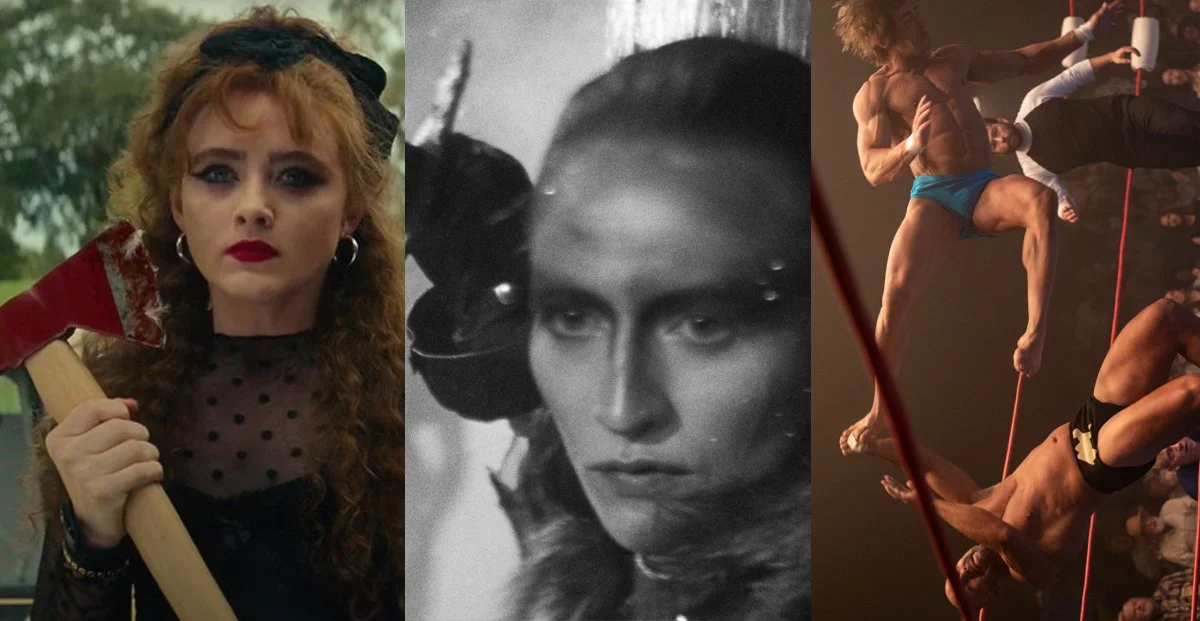Drive-Away Dolls Review: All Climax, No Foreplay
What has one car, two vaginas, three heads, and a case worth of forbidden Floridian treasures? Ethan Coen and Tricia Cooke’s Drive-Away Dolls has finally been released in theaters after its script has been kicking around since the early 2000s. Originally titled Drive-Away Dykes, the film stars Margaret Qualley and Geraldine Viswanathan as Jamie, a free-spirited Texan with a taste for lust, and Marian, an uptight professional who’s in desperate need of a break from life. After Jamie goes through a dramatic break up with her cop girlfriend, played by Beanie Feldstein, she decides to hitch a ride with Marian as she heads down to Tallahassee to visit her conservative aunt.
It’s clear that Coen and Cooke wanted to create an ode to a midcentury flavor of the sexploitation genre, but beyond the superficial set up there’s not much in way of tribute or addition. Instead, what follows is a series of short and punchy scenes, with an emphasis on brevity and edited like a rimshot, ensuring that we’re never allowed to settle into any one scene or dynamic. Abrupt time jumps and location shifts happen with cheeky aplomb, utilizing canned screen twirls and corny racecar wipes. Abrupt psychedelic interludes play us out of scenes like a vaudeville hook, slowing the story down in order to circle visual randomness that eventually settles into in plot relevant flashbacks. It’s all done with a tongue-in-cheek flourish but when everything feels overdone it’s hard to know where to center our patience.
Drive-Away Dolls is a let down, even for those of us who actually enjoy barely watchable sleazy ‘60s movies. It’s clear Coen and Cooke missed their window to ironically straddle the past while still wholeheartedly indulging in their cinematic kinks. There’s a palpable self consciousness to this film that undercuts its own enthusiasm. It feels too composed, too arms length, too worried about offending somebody somehow somewhere. It dabbles in light satire about stereotypes both social and political, if you look close enough there’s a whispered critique of the blurred boundaries of conservatism and liberalism. Then there’s a handful of sex scenes, but they all play out fairly demure; afraid to lean into a lascivious gaze, afraid to make uncomfortable jokes, afraid to say “dyke.” Instead we get a handful of out of focus close ups on what I have to presume were naked bodies.
Don’t get me wrong, it’s not that we need tediously long, explicit sex scenes with sleazy lingering shots and performative moaning. But if you’re going to play in this sandbox then by all means you may as well get up to your arms in nudie cuties. The joy of these midcentury genre films is in how they flirt, pick up and tease their audience with the idea of sexual fun – it’s less about getting off and more about the excitement of unbridled indulgence. It’s about the joy of frolicking and fucking. The closest we get to anything approaching that level of fantasy is in a car scene, the morning after a random drunken hook-up, with Marian asking “How was it?” and Jamie quipping “Bouncy.”
The theater around me was sure having a good time, but I couldn’t help but think it was mostly because they don’t know what they’re missing out on by settling for less. Are we so devoid of charismatic female actors that Margaret Qualley is meant to pass as not only gay but charming? Unfortunately she’s believably neither — she gets into some fun physicality and she has a nice earnestness around the eyes but she’s holding back. We see her in multiple sex scenes and yet it’s hard to believe she’s actually up there in anybody’s puss. She doesn’t have the swagger, the intriguing ticks, the big personality, the strong opinions, the quick flirtatious wink with the hands working overtime.
One of Coen and Cooke’s biggest missteps were in hiring actors as the leads instead of comedians. Hate to make the television comparison but Broad City’s Ilana Glazer and Abbi Jacobson were more believable as amorous friends than Qualley and Viswanathan. There’s an awkwardness between the two, they seem afraid to touch each other even when they’re making out. Viswanathan feels more believable than Qualley on whole, but it’s hard to watch her and not wish she would go a bit bigger in everything — you can play a guarded character and still emote stronger than merely widening your eyes. In comparison, Beanie Feldstein crushed it, seething with a rage that felt both heightened and emotionally true.
On whole Drive-Away Dolls isn’t a bad time. I liked the reveal of what’s in the case, certainly the last thing I expected and, while hardly biting, it delivers in part on some of the messy morality I longed for. I enjoyed Pedro Pascal and Matt Damon in their ten-second cameos, both hamming it up as they should be – they understood the assignment, as it were. In general it’s nice to see something so refreshingly unique in theaters again. A movie about two lesbians looking for love and Tallahassee is exactly the antidote to a never ending procession of sequels and remakes. I would even recommend you go see it in theaters so we can get more things like it.
But just know we deserve better folks. We can have the climax and the fantasy. Stop settling for the mechanical and start demanding the foreplay.







